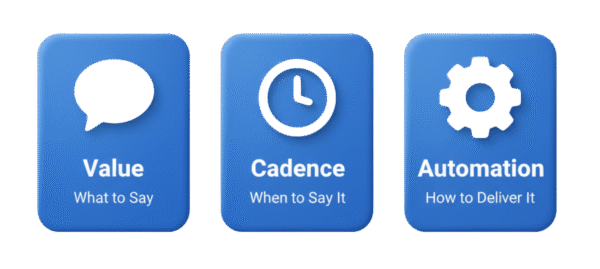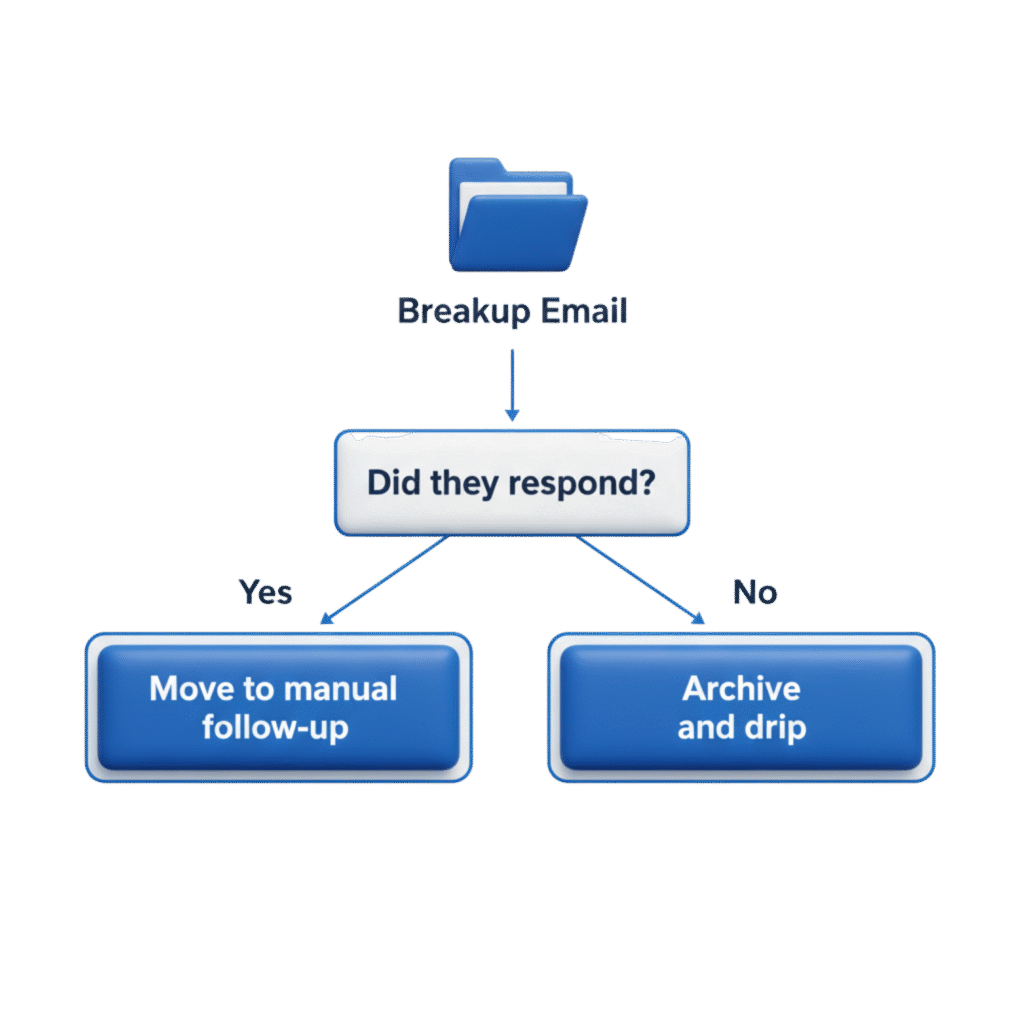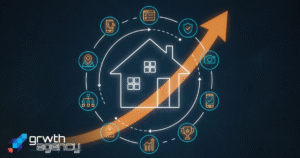Your time is your most valuable asset. As a builder or contractor, every minute you spend chasing cold leads manually is a minute you could be spending supervising a build, deepening relationships with customers, or making strategic investments in your business.
You’re paying good money for those leads — from your website, ads, or landing pages — and if your follow-up is messy, you’re just wasting money. Your leads are going cold, getting scooped up by faster, more responsive competitors, or simply forgetting you exist.
This is where a predictable, high-speed automated system beats manual effort every time.
The system works on three simple parts: What to Say (Value), When to Say It (Cadence), and How to Automate It (Efficiency).

What to Say (Value) — Stop Sounding Like a Salesman
When a homeowner fills out a form, they’re likely anxious and actively comparing multiple contractors. Your message has to cut through the noise by being brief, professional, and focused on providing immediate clarity about your process.

The Critical Window: Why the 5-Minute Rule is Non-Negotiable
You have a five-minute window to act. It’s not an arbitrary goal. It’s the moment the lead’s interest starts to plummet. If you wait too long, your chance of conversion drops by 80%.
You need a combination of an instant text/email followed by a quick scheduled phone call.
The goal here is not to sell. It’s to set the next clear expectation.
Actionable Email/Text Message Template:
“Hi [Lead Name],
This is [Your Name] from [Your Company]. I saw your inquiry about the [Project Type, e.g., kitchen remodel].
I’m free for a quick 10-min chat tomorrow morning at 9:30 AM to cover the preliminary scope and see if we’re the right fit.
Does that time work, or should I send over a quick calendar link?”
This template instantly qualifies the lead, acknowledges their project, and asks for a decisive response.
Delivering Real Value: Building Trust Through Email
If the initial contact fails, your automated emails need to earn the conversation. Don’t send a generic “just checking in” message. Your emails should focus on building confidence by answering the homeowner’s top unspoken fears:
- Email 1: Trust & Authority: Focus on social proof. Send 1-2 powerful, relevant testimonials or a direct link to your strongest project gallery. This instantly shows you deliver on your promises. If you can, tailor this to the specific project type the homeowner is interested in. (e.g., “Here’s a link to three kitchen makeovers we recently completed for inspiration.”)
- Email 2: Process & Clarity: Homeowners worry about the process. Link to your specific building process page (which you should definitely have on your website). This transparency positions you as a professional system, not a chaotic builder.
- Email 3: Differentiation (The Why Us?): Highlight your unique selling points. Do you offer fixed timelines? A client communication app? A superior warranty? Focus on the tangible benefits that justify your price.
The “Breakup” Email: Clean Out the Pipeline
This is your final, high-impact touchpoint. It forces an indifferent lead to confirm they are moving on, or it prompts them to re-engage immediately.
- Goal: Get a final decision (Yes or No) to clean your pipeline.
- Tone: Professional, not desperate. You could say something like, “Seems like you’re not quite ready to get started. Should we add you to our design inspiration newsletter instead?” That gives you some options to maintain the relationship, while helping you prioritize higher intent leads.

When to Say It: Defining Your Optimal Follow-Up Cadence
A successful cadence is front-loaded, persistent, and multi-channel. You need to hit them often in the first week, across phone, text, and email, to maximize the chance of contact while their interest is high.
The Structured 7-Day Intensive Sequence
Implement this exact sequence for maximum impact on new inbound leads:
| Day | Action | Medium | Goal |
| Day 0 | Introductory Text/Email | Text & Email | Acknowledge inquiry, set expectation |
| Day 0 | Call Attempt | Phone | Connection |
| Day 1 | Send Email 1 | Build Trust & Authority (Testimonials) | |
| Day 2 | Second Call Attempt | Phone | Check-in, leave a brief, process-focused voicemail |
| Day 4 | Send Email 2 | Explain Process & Clarity (The 5-Step Plan) | |
| Day 7 | Send Email 3 | Highlight your unique selling points. (Differentiation) | |
| Day 14 | Send the “Breakup” Email | Force a final decision, clean up the pipeline |
This ensures the lead receives several strategic contacts in the crucial first week.
Long-Term Nurturing: The Drip for Future Projects
Don’t discard non-responders. Move them to a low-frequency “drip” list. This strategy maintains your expert presence for the six, twelve, or eighteen months until they are finally ready to build.
Long-Term Content Must Be Genuinely Useful:
- Quarterly Market Updates: Data that shows you track costs and trends.
- Seasonal Maintenance Tips: Practical advice that positions you as an ongoing resource.
The content must be genuinely useful—never a sales pitch.
Automating your Follow-up Cadence
Automation is the only way to get predictable, high-level performance on your inbound leads and to free up your staff for more valuable activities.
The Power of CRM for Builders
Your CRM isn’t just a directory. It is your consistency machine. For a builder, the CRM must prioritize:
- Status Pipeline: Instantly visualize where every lead is (New, Qualified, Proposal, Closed).
- Automated Task Reminders: The system must automatically schedule your team’s next action (e.g., “Call John Smith at 2 PM”) based on the sequence.

Setting Up the Automated Sequence: The “Set It and Forget It” Workflow Map
Map your 7-Day sequence directly into your automation platform so it runs instantly whenever a new website inquiry hits your inbox.
The Essential Workflow Map:
- Trigger: New submission on your website contact form
- Action 1 (Immediate): Send confirmation email
- Action 2 (Immediate): Crucial Human Task. The system creates a high-priority task for your team: “Call New Lead” (The system schedules the human involvement).
- Action 3 (Delay 24h): Auto-send Email 1 (Trust & Authority)
- Action 4 (Delay 24h): Second Call Attempt
- Action 6 (Delay 2 Days): Auto-send Email 2 (Process & Clarity)
- Action 6 (Delay 3 Days): Auto-send Email 3 (Differentiation)
- Action 7 (Delay 7 Days): Auto-send “Breakup” Email
Integrating the Human Touch: Knowing When to Stop the Machine
Automation must stop the second the human conversation begins. The system needs a trigger (a reply to an email, a return call) that immediately pulls the lead out of the automated sequence and flags it for a manual, personalized follow-up.
Use automation to earn the conversation. Use human skills to close the deal.

The Optimization Loop: Testing and Tweaking What Works
Your initial set-up and messaging is a hypothesis, not gospel. You won’t get it perfect on the first try. The most successful contractors commit to continuous testing to fix the final leaks in their pipeline.
Focusing on Revenue Metrics: Response Rate and Meeting Booked Rate
Ignore “vanity metrics” like open rates. Focus only on the metrics that drive revenue:
- Response Rate: How often does a lead reply to any touchpoint in the sequence?
- Meeting Booked Rate: How often does the lead move from “Inquiry” to a scheduled “Discovery Call” or “Site Visit?”
If your response rate is low, test a new initial email. If your meeting booked rate is low, tweak your call-to-action.
Simple A/B Testing for Messaging and Timing
Run simple A/B tests on two key elements:
- Messaging Focus: Test whether your initial message gets a better response by, for example, focusing on “speed of build” or “predictability of budget.”
- Timing of Touches: Test whether your Day 2 call attempt connects better at 9:00 AM (before the homeowner starts their workday) or 4:00 PM (as they wind down).
Quarterly Review: What Did We Miss?
Every three months, review your closed-lost leads. Check the final message they received. Often, a tiny tweak to the messaging or schedule could have kept them engaged long enough to convert. This review turns failure into actionable future improvements.
Summary: Put The Lead Follow-Up Formula to Work
The Lead Follow-Up Formula is the foundation for a more profitable and efficient construction business. By mastering What to Say (Value), When to Say It (Cadence), and How to Automate It (Efficiency), you ensure every single lead receives the optimal sequence of communication, consistently and without fail. This system not only captures more projects but also immediately elevates your brand above competitors.

